The Irish Wolfhound Archives

Capt. Graham's
The Irish Wolfhound
1879
 |
IF YOU CLICK ON
ANY OF THE PAGES BELOW IT WILL TAKE YOU TO A
LARGER CLEARER IMAGE |
 |
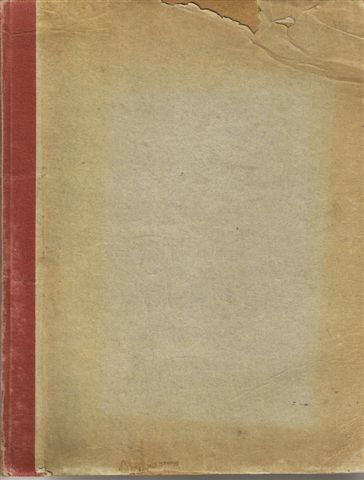

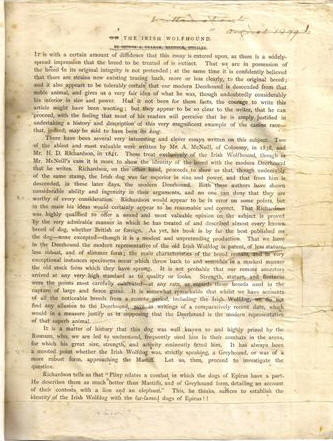

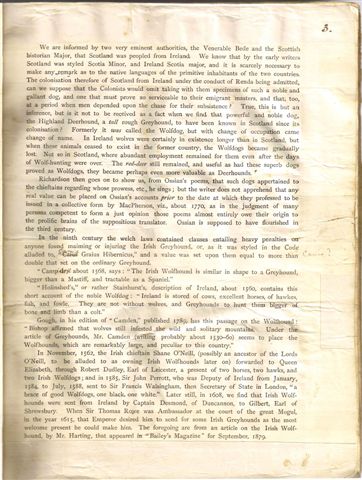
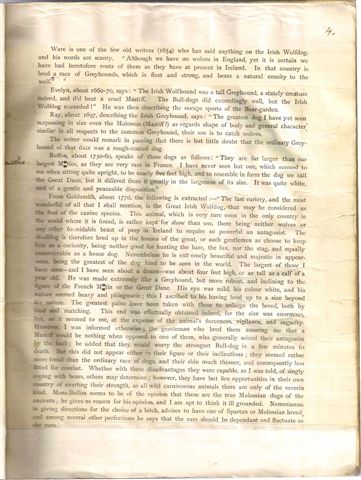
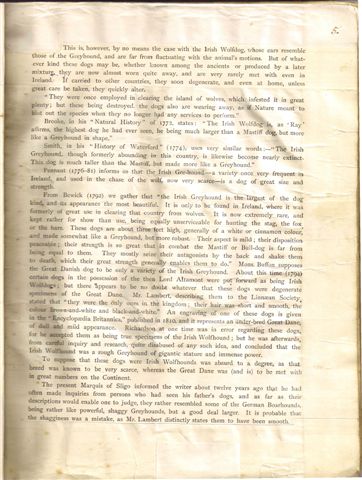
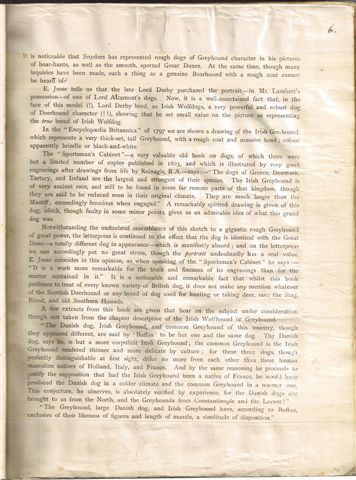
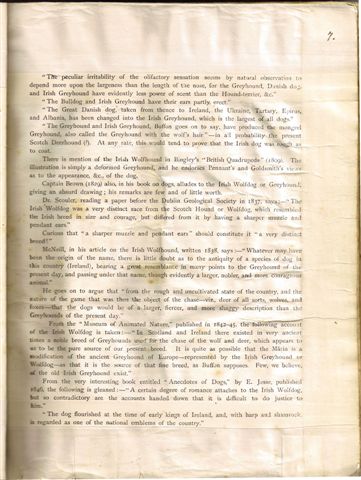
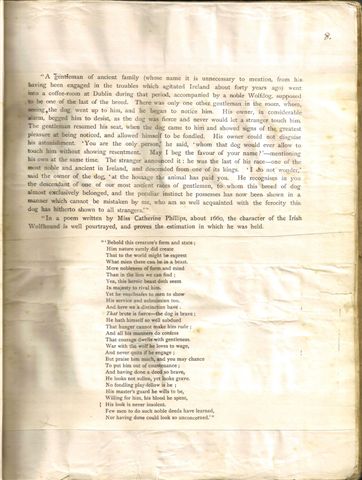

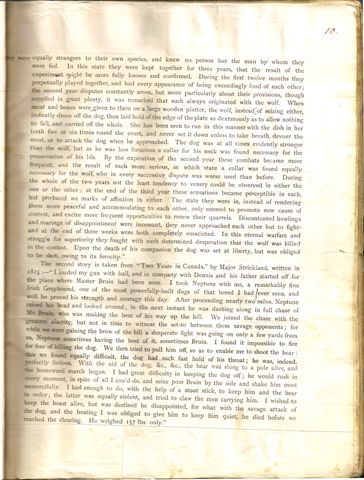
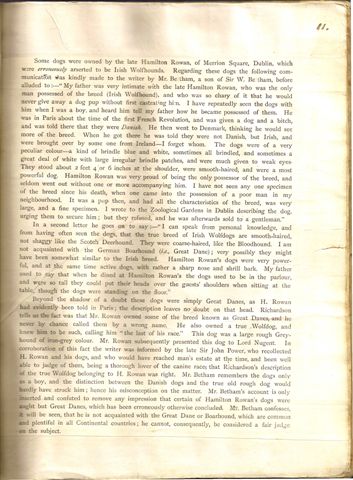
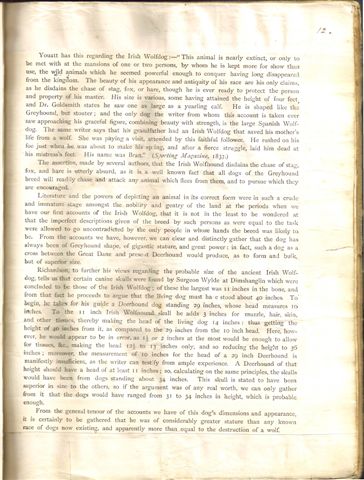
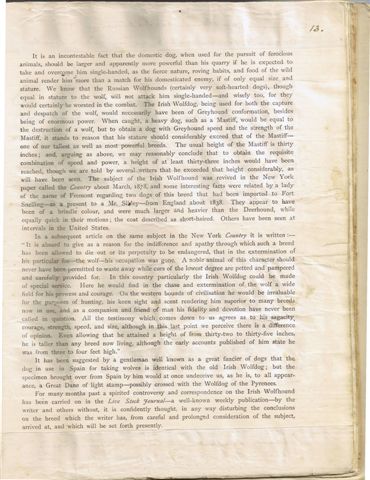

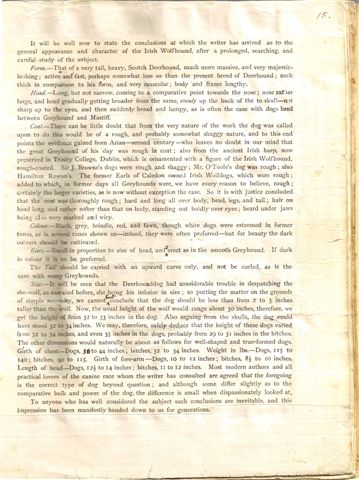
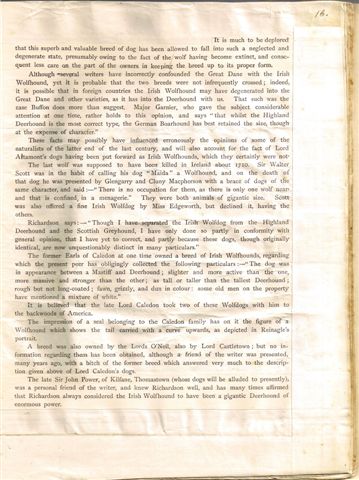

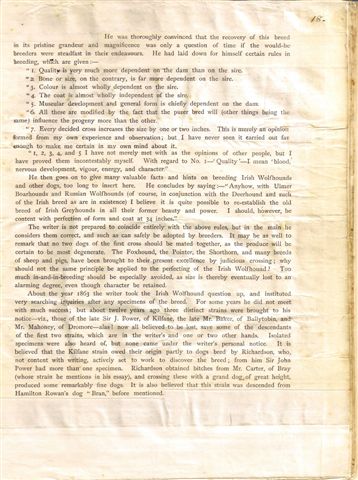
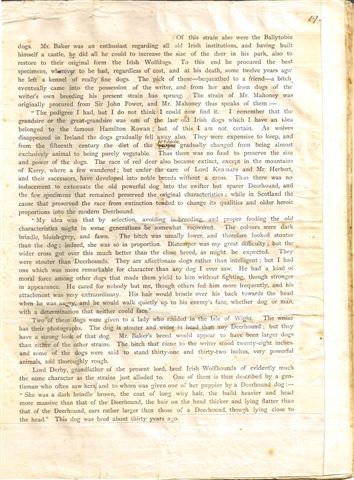

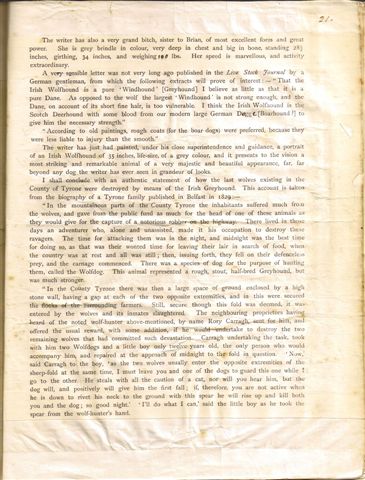
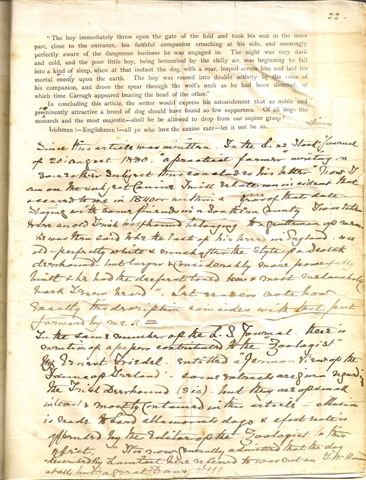
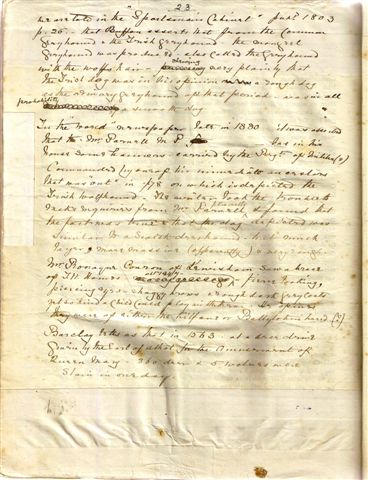
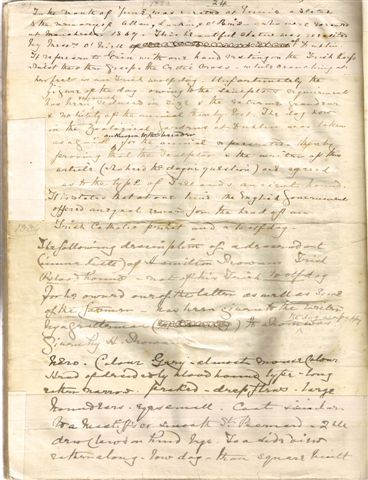
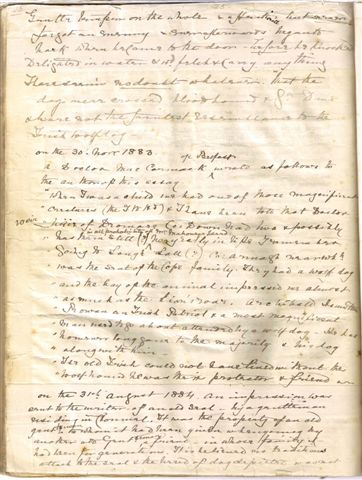
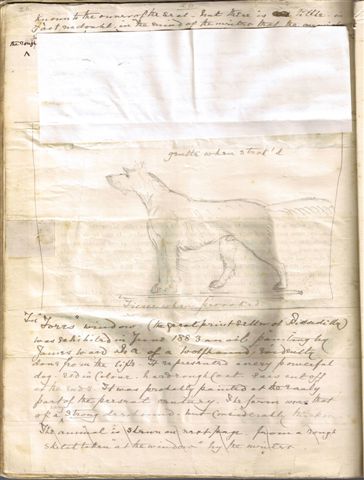
| Above right
Page 26 is shown with a flap up to
reveal a drawing.
To the right here
Page 26 is shown with the
flap down to reveal the writing.
|
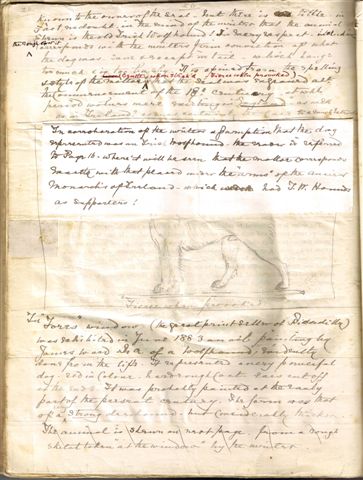 |
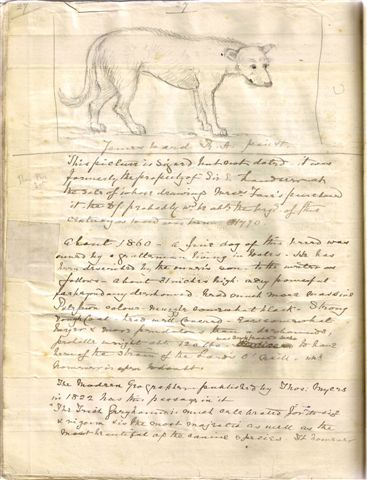
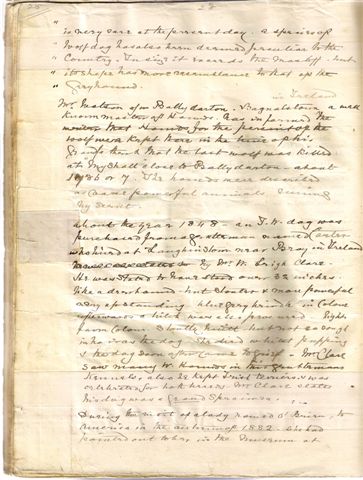
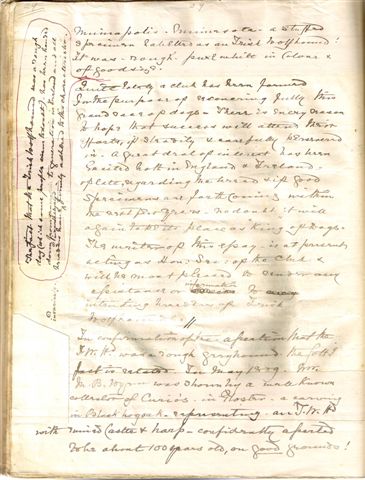
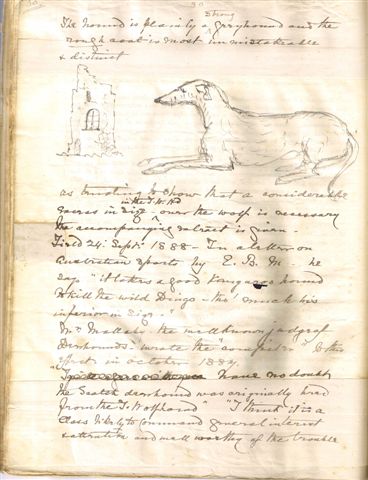
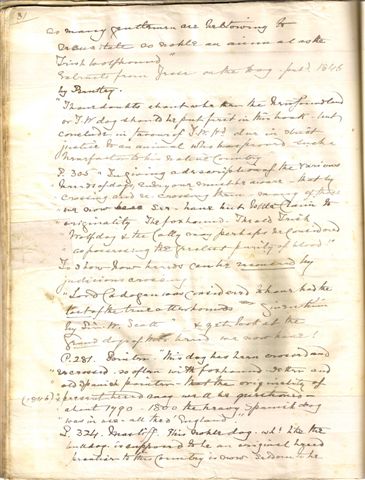
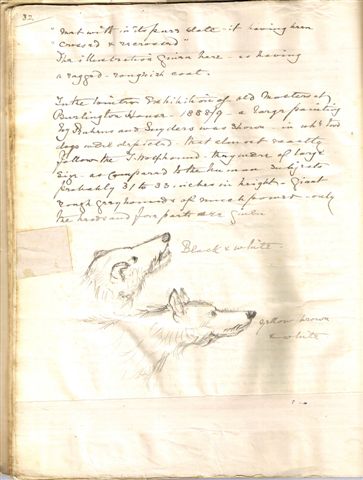
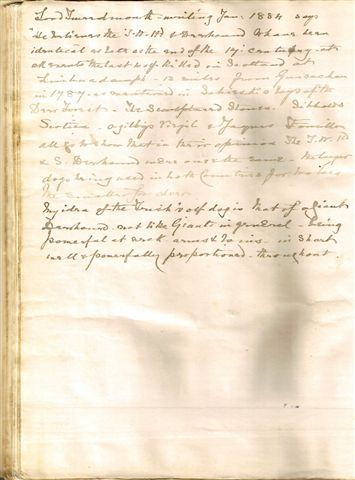
Capt G A Graham’s the
IRISH
WOLFHOUND 1879 Edition
Page 22
- 33
Graham’s handwritten notes transcribed
by Mrs Shirley Pfarrer, USA
Page 22
Since
this article was written in the Live Stock Journal on 20 August
1880 “a practical farmer writing on some other subject thus
concludes his letter. “Now I am on the subject Canine.
I will relate an incident that
occurred to me in 1840 or within a year of that date staying
with some friends in a Southern county.
I was taken here an old Irish wolfhound belonging to a
gentleman of means.
He
was then said to be the last of his breed in England -
was old - perfectly
white and much after the
style of a Scotch deerhound but larger and considerably more
powerfully built and he had the deepest
toned and most
melancholy bark I ever heard”
Let readers note how exactly this description coincides
with that put forward by me!!
In
the same number of the L. S. Journal there is mention of a paper
contributed to the “Zoologist” Ernest Friedel entitled a “German
View of the Fauna of Ireland” – some extracts are given
regarding the Irish deerhound (sic) but they are of small
interest and mostly contained in this article – allusion is
made to Lord
Altamont’s dogs and a foot note is appended by the Editor of the
Zoologist to this effect.
“It is now generally admitted that the dog described by
Lambert
here referred to was not an IW Hound
at all but a Great Dane!!!!!
Page
23
He wrote in
the “Sportsmen Cabinet” pub’d 1803
pg 26 - that Buffon asserts not from the Common Greyhound
and the Irish greyhound
- the mongrel Greyhound was produced – also called the Greyhound
with the wolfs
hair showing very plainly that the Irish dog was in his opinion
a rough dog as the ordinary Greyhound of that period – was in
all probably a smooth dog.
In
the World
newspaper late in 1880
it was asserted that Mr. Parnell MP
has in his house banners carried by the
Regiment of the Militia commanded by one of his immediate
ancestors that was “out”
in /98 on which is depicted the Irish Wolfhound.
The writer took the trouble to make enquiries from Mr.
Parnell personally and found that the fact was true, and that
the dog depicted was similar to a Scotch deerhound, but much
larger, more massive (apparently) and very rough.
Mr.
Ronayne Conron of Lewisham saw a brace of the IW Hounds about
1847, fierce looking, piercing eyes – shaggy brows and rough
dark grey coats yet so kind a child could play with them.
He opines they were of either the Kilfane or Ballytobin
breed. Barclay
tells us that in 1563 – at a deer drive given by the Earl of
Athol for the amusement of Queen Mary – 360 deer and 5 wolves
were slain in one day.
Page
24 1882
In the month
of June 1882 was erected at Ennis a statue to the memory of
Allan Larkin, and O’Brien who were executed at
Manchester
1867. This
beautiful statue was executed by Messrs O’Neill of
Dublin. It represents
Erin with one hand resting on the Irish harp whilst
the other grasps the Celtic cross – while crouching at her feet
is an Irish wolf dog.
Unfortunately the figure of the dog owing to the
sculptors requirements has him very much reduced in size and the
extreme grandeur and the nobility of the animal thereby lost.
The dog now in the Zoological Gardens at Dublin was taken as a guide unknown to the
breeder for the animal represented.
Thereby proving that the sculptor and writer of this
article (who bred the dog in question) are agreed as the type of Ireland’s ancient hound.
It is stated that at one time the English government
offered an equal reward for the head of an Irish Catholic priest
and a wolf dog.
1884
The
following description of a
descendant (immediate) of Hamilton
Rowan's Irish
Bloodhounds; not of
his Irish
Wolfdog for he owned
one of the latter as well a
some of the former -
has been given to the writer by a gentleman to whom the dog, as
a puppy, was given by H Rowan.
Nero.
Colour grey almost mouse colour; head, of decidedly Bloodhound
type,
Head
bloodhound type - long
extreme narrow peaked - deeps flews -large hound ears. Eyes
small Coat
similar to a Mastiffs or smooth St Bernard.
2 dewclaws on hind legs
To a side
view rather a long - low dog - then square built
Page
25 1897
Gentle
temper on the whole and affectionate but never forgot an enemy
and soon? afterwards began
to bark when he came to the door - before he knocked.
Delighted in water,
I. W. fetch and carry
anything.
There
seems no doubt whatsoever that the dogs were crossed
bloodhound and Great Dane and have not the faintest resemblance
to the Irish Wolfdog
On
the 30 November 1883
A doctor Mac
Cormack of Belfast wrote as follows to the author of this essay.
“When I was
a child we had a most magnificent creature (the I.W. Hound) and
I have been told that Doctor Weir, heir of Dromore, Co Down had
two and possibly has them still, in all probability of Mr.
Mahoney’s breed
Very
early in life I remembered going to Lough Lou, Co
Armagh to the estate of the Cope family
They
had a wolf dog and the bay of the animal impressed me almost as
much as the Lion’s roar.
Archibald Hamilton Rowan, an Irish Patriot and a most
magnificent man used to go about attended by a wolfdog.
He has . . . . . . . .
long gone . ..to the majority and
his dog along with him.
The
old Irish could not have lived without the wolfhound He was
their protector and friend and on the 31st August
1884 an impression was sent to the writer of an old seal by a
gentleman residing in Clonmel.
It was the property of an old
gentleman to whom it had been given when young by another old
gentleman, a friend
in whose family it had been for
generations.
It is believed no traditions attach
to the seal and the breed of dog depicted was not known to the
owner of the seal
1879
Page 26
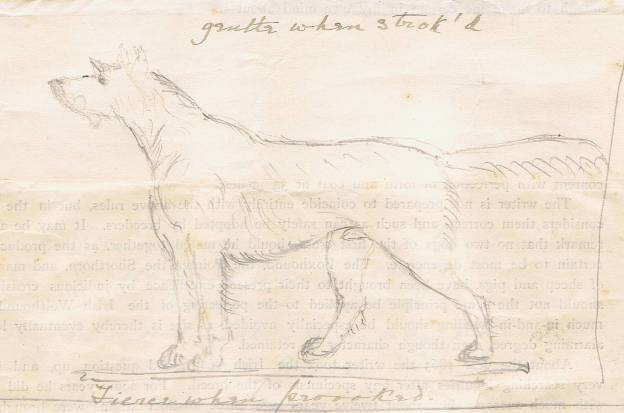
“Gentle
when stroked fierce when provoked”
Known
to the owner of the seal – but there is little, in fact, no
doubt in the mind of the writer that the animal shown is the old
Irish Wolfhound!
In every respect including the rough
coat it corresponds with the writers firm conviction of what the
dog was -
except in tail – which hangs too
much and is too bushy.
It is opined from the spelling and
style of the motto “Gentle when Strok’d fierce when Provoked”
that the seal was engraved about the
commencement of the 19th century - at the period
wolves were existing in England
as well as in Ireland?
As was certainly the case to a much
later date. In corroboration of the writers assumption that the
dog represented was an Irish Wolfhound the reader is referred to
page 16 – where it will be seen that the matter corresponds with
that placed under the “arms” of the ancient monarchs of
Ireland
– which had IW hounds as supporters !
In
“Fores” window
(the great print seller of Piccadilly) was exhibited in June
1883 an oil painting by James Ward R A. of a
“wolfhound”
evidently done from the life it represented a very powerful dog
– red in
colour – hard
rough coat – ears cut off at the ends.
It was probably painted at the early
part of the present century.
The form was that of a (very) strong
deerhound but considerably thicker.
CROSSED OUT
The
animal is shown on next page from a rough sketch taken at window
by the writer
Page 27
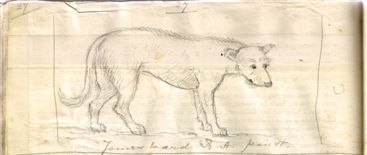
James
Ward R A Print
This
picture is signed but not dated – it was formerly the property
of Sir E Landseer at the sale of whose drawings Messers Fore’s
purchased it
the
date probably wd be about the beginning of this century as Ward
was born 1770
About
1860 - a fine dog of this breed was owned by a gentleman living
in Wales.
He has been described by the owner’s
son – to the writer as follows – about 31 inches high - very
powerful – far beyond any deerhound - head much more massive.
Pal….ion?
colour – muzzle somewhat black.
Strong rough coat – head well
covered – ears somewhat larger and more pendulous than a
deerhounds, probable weight about 120 lbs was suppose to be have
been of a strain of the Lord O’Neill
.
. . . . . open to doubt.
The Modern
Geographer published by Thos Myers in 1822 has this passage in
it
“The Irish
Greyhound is much celebrated for its size and
vigour and is the
most majestic as well as the most beautiful of the canine
species.
Its number
Page
28
is very rare
at the present day. A species of wolfdog has also been deemed
peculiar to the country. In size it exceeds the Mastiff – but
its shape has more resemblance to that of the Greyhound.
Mr.
Watson of Ballydarton, Bagnalstown in Ireland,
a well known master of Hounds - has informed the writer that
Hounds for the pursuit of the wolf were kept there in the time
of his grandfather and that the last wolf was killed at “MyShall”
close to Ballydarton – about 1786 or 7.
The hounds were described as course
powerful animals running? by scent.
About
the year 1848 – an IW dog was purchased from a gentleman named
Carter who lived at Loughinstown near Bray in Ireland
by Wm W. Leigh Clare. He was stated to have stood over 32
inches. Like a deerhound – but stouter and more powerful very
upstanding blue grey brindle in colour afterwards a bitch was
also procured light fawn colour . . . . . . . . . . but not so
rough in hair as the dog.
She died whilst pupping and the dog
soon after came to grief.
Wm Clare saw many W Hounds in this
gentleman’s kennels; also he kept Irish Terriers and was
celebrated for both breeds. Wm Clare states his dog was a grand
specimen.
1879
Page
29
During
the visit of a lady named O’Brien to
America in the autumn of 1882
she had pointed out to her in the Museum at
Minneapolis
Minnesota a
stuffed specimen labeled as an Irish Wolfhound !
It
was rough – pure white in colour and of good size
Ed note:
see note at end of this text.
Text
insert from side of page
The
fact that the Irish Wolfhound was a rough dog (which some people
seem to doubt has been handed down from generation to generation
in Ireland and all breeders
have invariably and firmly adhered
to this characteristic.
Quite
lately a club has been formed for the purpose of recovering
fully this grand race of dog.
There is every reason to hope that
success will attend their efforts, if steadily and carefully
preserved in a great deal of interest has been . . . . . .
both in
England and Ireland,
of late, regarding the breed and if good specimens are
forthcoming within the next few years – no doubt it will again
take its place as “King” of Dogs.
The writer
of this essay is at present acting as Hon Sec of the Club and
will be most pleased to render any assistance or information to
intending breeders of Irish Wolfhound.
In
confirmation of the assertion that the I.W.H was a rough
greyhound the . .
. . . . . . . . . . . . . .
In May 1889 W. M. B. Wynn was
shown by a well known collector of Curios in Glostr. a carving
of Black Bog Oak representing an IWH with a ruined castle and
Harp – confidently asserted
to
be about 100 years old, on good grounds !
Page
30
The hound is plainly a strong greyhound and the rough coat is
most unmistakable and distinct
%20of%20Gr%201879full%20p%2030%20%20CCI00094332.jpg)
As
tending to show that a considerable excess in size in the I.W.H.
over the wolf is necessary.
The
accompanying extract is given – Field 24 Sept 1888 -
In a letter on Australian Sports by
E.B.M. he says”: “it takes a good kangaroo hound to kill the
wild dingo – tho’ much his inferior in size”
Wm Mallaby,
the well known judge of Deerhounds – wrote the “compiled” to
this effect in October 1887
“I
have no doubt the Scotch deerhound was originally bred from the
I. Wolfhound”
“I think it is a class likely to
command general interest and attention and well worthy of the
trouble.
so many
gentlemen are bestowing to resuscitate so noble an animal as the
Irish Wolfhound”
Extracts
from
Jessie on the dog,
published1846 by Bentley
“I
have doubts about whether the Newfoundland or I.W dog
should be put first in this book – but concluded in favour of
I.W.Hd due in strict justice to an animal who has proved such a
name factor to his native Country”
Page
305. In giving a description of the various breeds of dogs
everyone must be aware that by Crossing and re-crossing them –
many of these we now see have but little claim to originality.
The
foxhound, the old Irish Wolfdog and the Colly may perhaps be
considered as possessing the greatest purity of blood”
To show how
breed can be recovered by judicious crossing
“Lord
Cadogan was considered to have had the last of the true
otterhound given him by Sir W Scott and yet look at the grand
dog of this breed we now have!
Page
281. Pointer
– this breed has been crossed and recrossed
- so (1846) x with foxhounds
setters and old Spanish pointer that
the originality of (the
present
breed may well be questioned – about 1790 – 1800 the heavy
Spanish dog was in use all thro’
England.
Page 324.
Mastiff. this noble dog, which like the bulldog, is supposed to
be an original breed peculiar to this country is now seldom to
be not with in its pure state – it having been crossed and
recrossed
This
illustration given here is having a ragged roughish coat.
In the Winter exhibition of Old
masters at Burlington House - 1888/9 - a large painting by
Mohern & Snyders was shown in which two dogs where depicted.
That almost exactly follow the I.
Wolfhound - they were of large size - as compared to the human
subjects probably 31 to 33 inches in height. Great rough
greyhounds of much power - only the heads and fore parts are
given
%20of%20Gr%201879full%20p%2032%20%20CCI00096336.jpg)
Page
33
Lord
Tuirrdmonth (?)
-
writing Jan 1884 says “ he believes
the I.W.Hd and Deerhound have been identical as late as the end
of the 17 century - at all events the last wolf Killed in
Scotland at Lindindrumph (?)
-
13 miles from Guisachan in 1787 as mentioned in Sohiestis (?)
day of the deer forest.
The
. . . . . . stones .
. . . . . . . .
Scotica
- a gilbys virgil and Marquis (?)
Famillon (?).
All go now that in their opinion the
I.W. Hd and S. Deerhound were one and the same -
the larger dogs bring used in both
countries for wolves - the smaller for deer.
My
idea of the Irish Wolfdog is that of a giant Deerhound not like
Giants in general - being powerful at neck - arms and loins - in
short
well and powerfully proportioned
throughout.
END
********************************************************
Ed Note: Referring back to the
earlier text
During
the visit of a lady named O’Brien to
America in the autumn of 1882
she had pointed out to her in the Museum at
Minneapolis
Minnesota a
stuffed specimen labeled as an Irish Wolfhound !
It was rough – pure white in colour
and of good size
Judy
Simon kindly sent this reply to my enquiry re the stuffed white
Irish Wolfhound.
I
live in Minneapolis,
and I know there is no stuffed Irish wolfhound on display here.
I do know there is a painting of a wolfhound at a Governor’s
mansion. Henry Sibley had 2 IWs. Here is an article about Henry
Sibley and a couple excerpts from it
http://collections.mnhs.org/MNHistoryMagazine/articles/41/v41i05p217-228.pdf
Henry
Hastings Sibley, fur trader,
military officer, and
the first governor of
Minnesota.
His public career is well known;
his exploits as a big
game hunter are perhaps
less familiar. Sibley
was a frequent contributor
"The
party was well armed with short,
heavy rifles,
double-barreled guns, single-barreled
flintlocks, tomahawks,
and hunting
knives. Two Irish
wolfhounds accompanied
the hunters; one of
them, Lion, had been
presented to
Sibley by Captain Martin
Scott, a famous army
marksman who was
stationed at
Fort
Snelling for a number of
years and eventually
was killed in the Mexican
War."